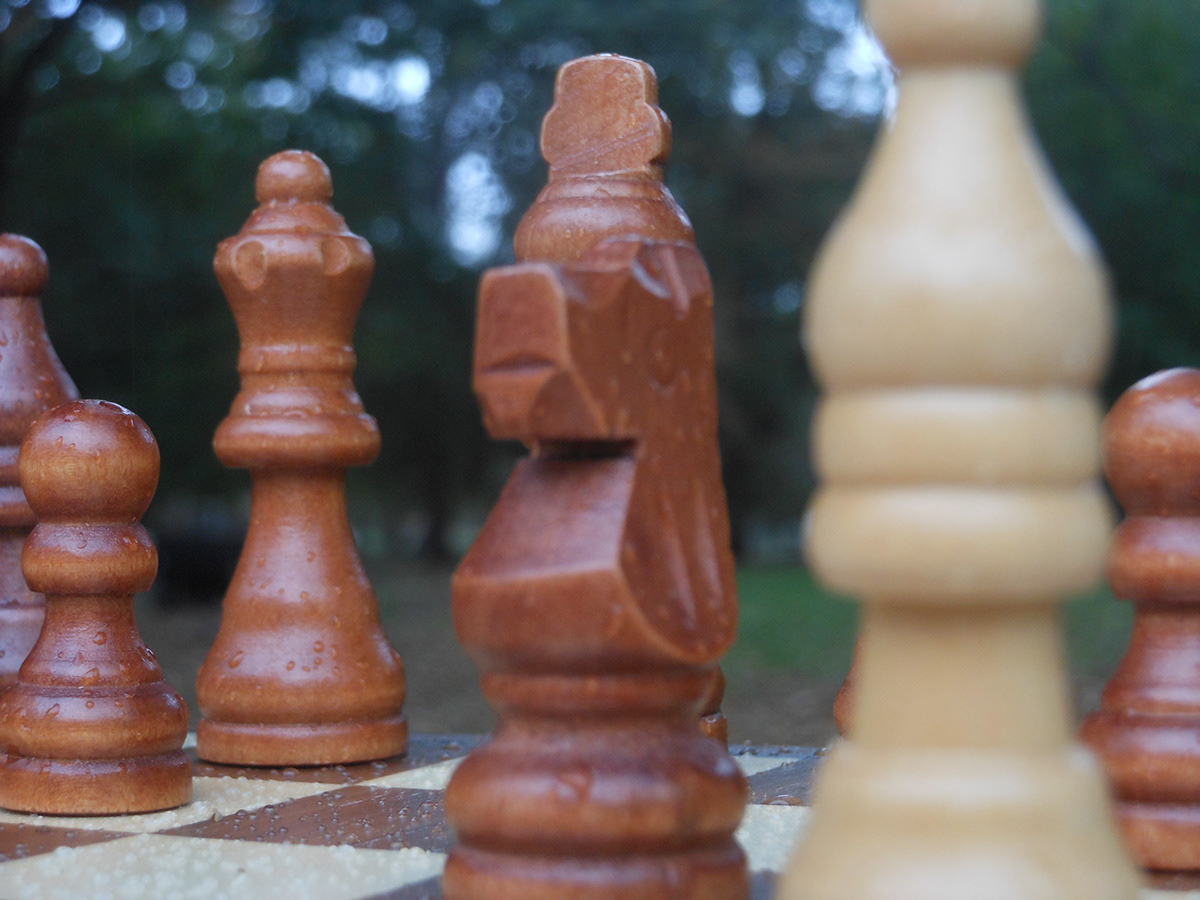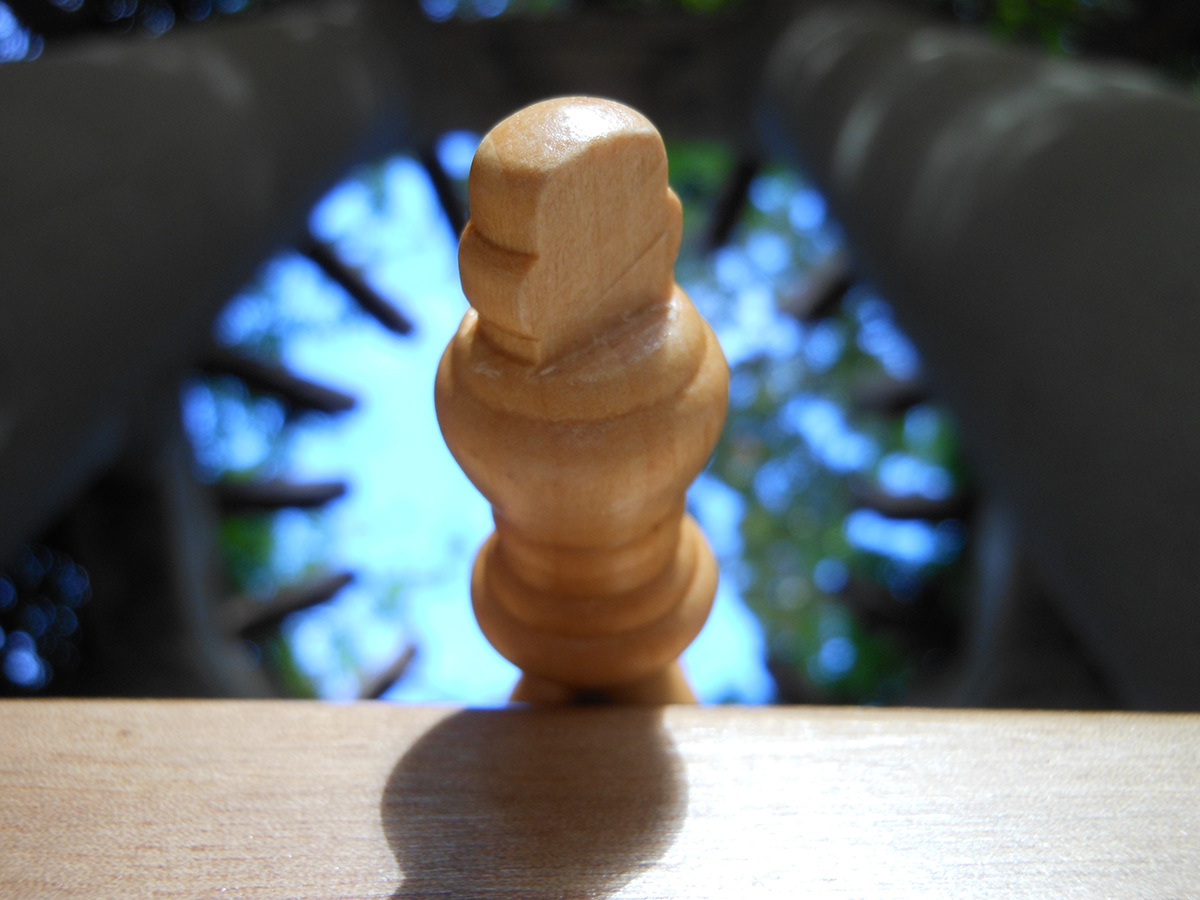
This photo employs a heavy focus on geometry and direction to emphasis the formality and rigidness of the game. However, the shot loses order as it travels upwards, the chairs being slightly disordered and the trees above growing freely in any direction. Just beyond the board are leaves and other natural litters, reinforcing the untouched nature of the area. No humans exist in this reality, only the chess pieces remain as an artifact. Extreme symmetry of the board and it's pieces are parallel to the heavy tradition and formality that surrounds chess, a game about the otherwise brutal affair of war.

The pawn is placed in the center of the shot; the space around the pawn is filled by the royal pieces, restricting any potential errant movement of the pawn. The depth removes the king and queen from the action though, as the pawn must fight alone. In chess, the pawn can only move forward. The rules of the system determine it so, even though the people who made the rules have long passed. The pawn does not choose to move forward, he is pushed. Heavy canting breathe some life into an otherwise dull shot, as well as reinforce the twisted nature of the pawn's situation.

The knight in the center of the frame appears to wear the crown of the King behind it. She borrows the king's strength and takes on her duty as a badge of honor. To her left is the Queen and her right the white bishop. Both are placed equal distances away on by appearance, but the bishop is closer in actuality. The rain and darkened atmosphere reinforce the strength of the knight, standing proud amongst even mother nature's wrath. Despite the power of her position and cause, she cannot strike back against the imposing bishop.

Heavy depth of focus and framing make the queen stand out among the other pieces. She's squeezed between the black king, his queen, and his bishop- their heads standing well above the white queen's. The only other white piece that can be seen is the pawn, balancing the composition but providing little notion of strength for white. the other white pieces are notably missing or covered up as well, making the queen seem unnaturally alone. The grass in the extreme foreground of the shot call to mind a person in hiding and secret predators. Slight canting expresses the unease that the white queen feels, the shot being "not quite right".

This shot scans over the playing field, establishing the development of the conflict. The black pieces are arranged in a straight line that divides the photo, giving the black army a large section of uncontested space. White is pushed back to the corner, emphasizing the overwhelming force black has. This arrangement is noticeably unnatural for a chess game, indicating that the pieces are transcending the game itself to take on a more life like quality.

The bottom of the squares are aligned horizontally, though all the vertical perspective lines and heading to a perspective point in the top left, as opposed to the perspective made by the seating that ends at the stage. The concrete in the background also move horizontally, but are not parallel to the chess board. This opposition of direction and perspective dissolve what was an otherwise systematic set of photos. This utilization of perspective emphasizes the decay of the systems that govern the game.

As she lays dying the queen stays in focus, the black pieces out of focus. The headspace of the black queen is partially cut off as she looms over the now dead queen, stripping her of some her humanity. Some pawns watch from the background to the right, and the king to her left. Of particular note is that the white queen has the first inherently unnatural position in chess, her base off the board and unaligned to grid. Through her death, she escapes the game. One may feel as though the queen stares at them behind the camera, despite having no eyes.

This shot emphasizes the white king alone. While I was considering to have the opposing king and queen loom over him in dying moments, I opted for something more serene. For the pieces, chess is less a game and more a prison. The pieces are instructed from creation what they may and may not do. Their entire is predetermined, to live and die for some unknown cause. To be brought forth for execution by beheading is an emotional affair, something novel to the faceless game of chess. In trying to capture that emotion, the king's head looms over the board turned guillotine. However, the king will soon be free.
